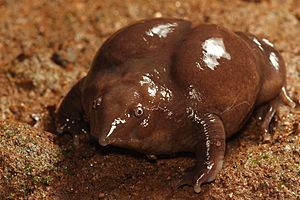Bhupathy's purple frog facts for kids
Quick facts for kids Bhupathy's purple frog |
|
|---|---|
| Conservation status | |
|
Not evaluated (IUCN 3.1)
|
|
| Scientific classification | |
| Genus: |
Nasikabatrachus
|
| Species: |
bhupathi
|
The Bhupathy's purple frog (Nasikabatrachus bhupathi) is a unique type of frog. It belongs to a family of frogs called Sooglossidae. This special frog lives in the Western Ghat mountains in India. It is known for its purple skin and for living underground almost all the time.
Contents
Meet the Purple Frog: What It Looks Like
Most frogs dig into the ground a little, but Bhupathy's purple frogs spend nearly their whole lives underground. They have special front legs that look like small shovels. These "shovels" help them dig through the soil easily.
They also have long noses. This long nose lets them stick their tongue above the ground. They use their tongue to lick the surface and catch ants to eat. Unlike many other frogs, their tongues do not shoot out and pull back quickly.
Adult Bhupathy's purple frogs have purple skin. They also have a thin blue ring around each eye.
This frog has one close relative, the purple frog, N. sahyadrensis. This relative was first found in the Western Ghats in 2003.
Life Cycle: From Tadpole to Adult
The tadpoles of Bhupathy's purple frog are quite unusual. They do not swim in ponds or streams like most tadpoles. Instead, they hold onto stones behind waterfalls. They stay there for about six months, eating algae that grows on the rocks.
Young frogs are called imagos. When they are young, their skin is brown. As they grow into adult frogs, their skin changes to a purple color.
Adult frogs only come out from underground when the rain starts. This happens at the beginning of the northeast monsoon season. They come out to find mates and lay eggs.
How This Frog Was Found
Scientists from Hyderabad's Center for Cellular and Molecular Biology discovered this frog in 2017. They decided to name the frog after Dr. Subramaniam Bhupathy. He was a scientist who sadly passed away in the Western Ghat Mountains in 2014.
The scientists wrote about N. bhupathi in Alytes. This is the official magazine for people who study and protect amphibians. They found N. bhupathi by listening for frog sounds coming up from underground.
Elizabeth Prendini, from the American Museum of Natural History, helped write the scientific paper. She said, "This frog family is very old, and there are not many different kinds of them. So, finding this new one is very special and unusual."
The scientists did not share the exact place where they found the frogs. This was because the land was private property.
The Indian government helped pay for this discovery. It was part of a bigger project to study the DNA of every frog in the country.
An Ancient Connection: Continents and Frogs
Some scientists have an interesting idea about N. bhupathi. This frog lives in India, but it has close relatives in the Seychelles. The Seychelles are islands near Africa.
This connection supports the Gondwanaland idea. This idea explains why the continents are where they are today. It says that Africa and India used to be part of one very large continent called Gondwanaland. Over millions of years, this supercontinent slowly broke apart. This movement is called continental drift. The fact that similar frogs are found in places that were once connected helps prove this ancient theory.


